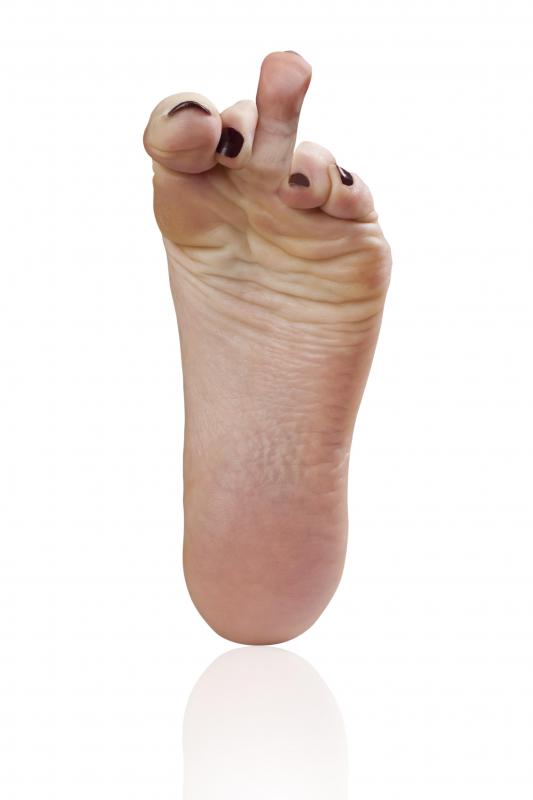At WiseGEEK, we're committed to delivering accurate, trustworthy information. Our expert-authored content is rigorously fact-checked and sourced from credible authorities. Discover how we uphold the highest standards in providing you with reliable knowledge.
What is a Deformity?
When humans, animals or plant life have specific parts that are distorted or disfigured to some degree, this is often known as a type of deformity. If these parts take on a rather odd shape or nonconformity, it will often be labeled as deformed. There are many types of deformities affecting all aspects of life, although the most common and researched would be those involving human beings.
Deformities can happen for various reasons and are commonly seen in infants born with birth defects. Certain areas of the body might be deformed due to a genetic factor or an environmental issue. Deformities involving the face and skull are one kind seen in newborns. Medical experts and scientists are still searching for clues to determine the cause of such abnormalities. Many of these deformities require repair through extensive surgery.

There is one type of facial deformity that affects newborns called Treacher Collins Syndrome. Caused by a genetic factor, this disease causes severe deformities within the structures of the face and head. It is a craniofacial deformity, which can require years of reconstructive surgery.
Other types of deformities include limbs that are unmatched. One leg that is shorter than the other or partially formed is considered a medical deformity. Individuals born with partially or underdeveloped limbs have deformities as well. Some infants are born with six toes on one foot or an extra finger, for instance—typically, the extra digit can be surgically removed or left alone if it does not interfere with the quality of life. In most cases, it is an option to be discussed with the physician.

Any malformation that occurs within the structure of the body is considered to be a dysmorphic feature. One such dysmorphic disorder is skeletal dysplasia. Common findings might include misshaped features within skeletal structures and bones. Such deformities primarily affect the limbs.
Animals are also born with deformities. A deformity in a puppy or kitten might manifest in disproportionate limbs or a protruding breastbone. There have been amphibians, reptiles and mammals born with two heads. A human with a parasitic twin conjoined at the head is believed to have a condition called craniopagus parasiticus. This is an extremely rare and severe deformity.

Deformities and syndromes involving human appearance are often the reason behind reconstructive surgery. If there is something to work with and a surgeon is able to perform reconstruction, someone with a deformity has the potential to lead a normal life.
AS FEATURED ON:
AS FEATURED ON:













Discussion Comments
@wavy58 – My brother has horseshoe kidney. When he was born, his kidneys were fused together at a point, creating a horseshoe shape.
This puts him at greater risk of kidney and urinary tract infections, kidney stones, and even kidney cancer. So, he has to have an ultrasound done once every three years to make sure he hasn't developed cancer.
He isn't in pain all the time. Sometimes, he will have abdominal pain because of it, but not continuously. His kidneys ache when he gets an infection, and he has to go get antibiotics promptly so that his kidneys don't suffer damage.
Has anyone ever heard of a kidney deformity called “horseshoe kidney?” A friend of mine told me that he had it, but I didn't want to press him for information.
I know that he gets kidney stones a lot, but that's about the only complication from it that I am aware of. He misses work a few times a year because he is in the hospital getting his stones busted up so that they can pass.
I know that kidney stones are painful, but I wonder if this condition is painful in itself. I hope he isn't uncomfortable all the time because of it.
My elderly neighbor had a deformity in her leg. One leg was drastically shorter than the other, and I imagine that her family never had the money for surgery, if it even was available as she was growing up.
She wore a special shoe on the short leg. It had a heel that was several inches thick. She also had to move around on a walker, but I think she probably wore this shoe for many years before she needed assistance with her walking.
I know childhood must have been hard for her. She couldn't run and play with the other kids, and it must have been difficult for her to find a suitable outlet for her energy.
I found a starving puppy in the road and brought him home, and at the time, he didn't show any signs of deformity. His bones were protruding and his toes had no meat on them, but he appeared to have a normal shape.
Within a couple of weeks, as he began to put meat on his bones, I started to see that the joints in his legs were becoming deformed. What I guess you would call his knees were poking out, and this was causing his feet to turn inward a bit.
The vet told me that this was happening because he didn't receive the correct nutrition at a vital point in his development. He was nine weeks old when I rescued him, and up to that point, who knows when he got to eat?
So, she gave him some calcium tablets. I had to give him two a day for about a month. I have seen a huge improvement in his joints, and though the knees still protrude a little bit, his feet are no longer pointing inward, so his deformity is clearing up.
Post your comments